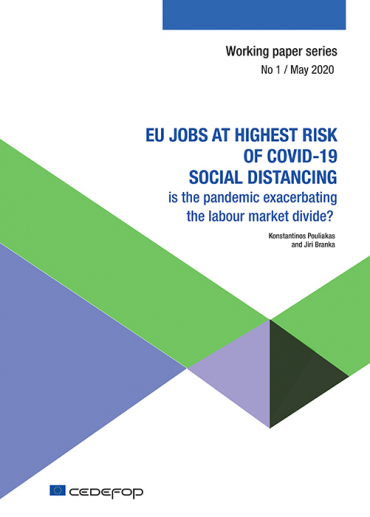Cedefop research suggests a link between remote working and increased participation in some types of remote learning during – and potentially after – the pandemic.
With more than 94% of the world population affected by lockdown measures, remote working became widely used as a safeguard against the possibility of complete job loss, furlough, business closure as well as extraordinary child care demands. Early assessments suggest that some 40-70% of active workers were affected, compared to about 15-17% of EU workers on average before the pandemic. Several new studies have also highlighted that between a quarter to a third of all jobs in European economies could potentially be performed from home.
An unintended positive side-effect of staying at home is people’s renewed interest and engagement in vocational education and training (VET). Interest in online learning seems to have surged during the recent coronavirus period, particularly though massive open courses (MOOCs). Cedefop evidence, however, cautions against a higher dropout risk for vulnerable learners engaging in distance learning.
It is too early to assess conclusively whether these coronavirus-induced shifts in homeworking and remote learning will be sustainable features of EU labour markets. Cedefop’s second European skills and jobs survey will provide some new insights into the long-lasting effects of the coronavirus, while several commentators already predict that the impact of Covid-19 on the future work organisation is here to stay.
Remote working in the EU before the crisis
One year before the coronavirus crisis, only 14% of EU-27 workers engaged in remote work, ranging from very high shares (over 37%) in the leading countries – Sweden and the Netherlands – to a mere 1-2% in Bulgaria, Romania and Cyprus.
Figure 1. Percentage of employed persons working from home, EU-27 plus UK, NO, IS, CH, 2019

NB: Summation of employed persons working from home sometimes or usually.
Source: European labour force survey, Eurostat [lfsa_ehomp].
Cedefop mapped the profile of workers who had some formal work-from-home (WfH) arrangement with their employer before coronavirus struck (Figure 1). WfH is more prominent among males, natives and older employees. It is more often used by individuals with higher levels of education and those in higher-skilled jobs and industries, including the ICT, professional and scientific activities, real estate and education sectors. WfH is also associated with some elements of poor job quality, such as more and atypical work hours (e.g. working on weekends and shifts), part-time work and multiple job-holding.
Cedefop expert Konstantinos Pouliakas, responsible for the research, remarks that ‘based on Cedefop analysis (Cov19R index), many of the population groups facing higher Covid-19 social distancing risk, such as women, immigrants and the lower-skilled, were the ones least likely to benefit from the option of WfH in the pre-coronavirus era.’
Will remote working boost remote learning?
Cedefop’s empirical analysis reveals a positive relationship between working from home and workers’ higher participation in non-formal learning (Figure 2). Remote workers are more likely to have participated in courses, seminars, conferences or to have received private lessons or instruction outside the regular education system in the last four weeks of being surveyed. They did so mostly for job-related purposes, primarily seeking to acquire further knowledge in fields such as social sciences, business and law, education and ICT.
Figure 2. Percentage of employed persons working from home and doing non-formal learning, EU-27 plus UK, NO, IS, CH, 2018

NB: Mean values per country of employees (aged 15-64) working from home and attendance in non-formal taught learning activities.
Source: European labour force survey microdata; Cedefop’s own analysis.
Is remote/online learning here to stay?
Following the implementation of specific policy measures in several European countries during the pandemic to promote the use of distance/remote learning, Cedefop’s evidence that there may be a reinforcing link between teleworking and continuing VET is encouraging. There is still a long way to go as only 8% of EU citizens followed an online course in 2019. More research is needed to develop the right policies to ensure that EU workers can reap the full benefits of distance working and learning, particularly given the inevitable loss in organisational informal learning and innovation – the most prominent channel of continuing learning – that is expected to follow the distancing of workers from physical workplaces.
Cedefop’s ongoing research findings on the link between distance working and learning will be published in a dedicated Cedefop working paper in the second half of 2020.




